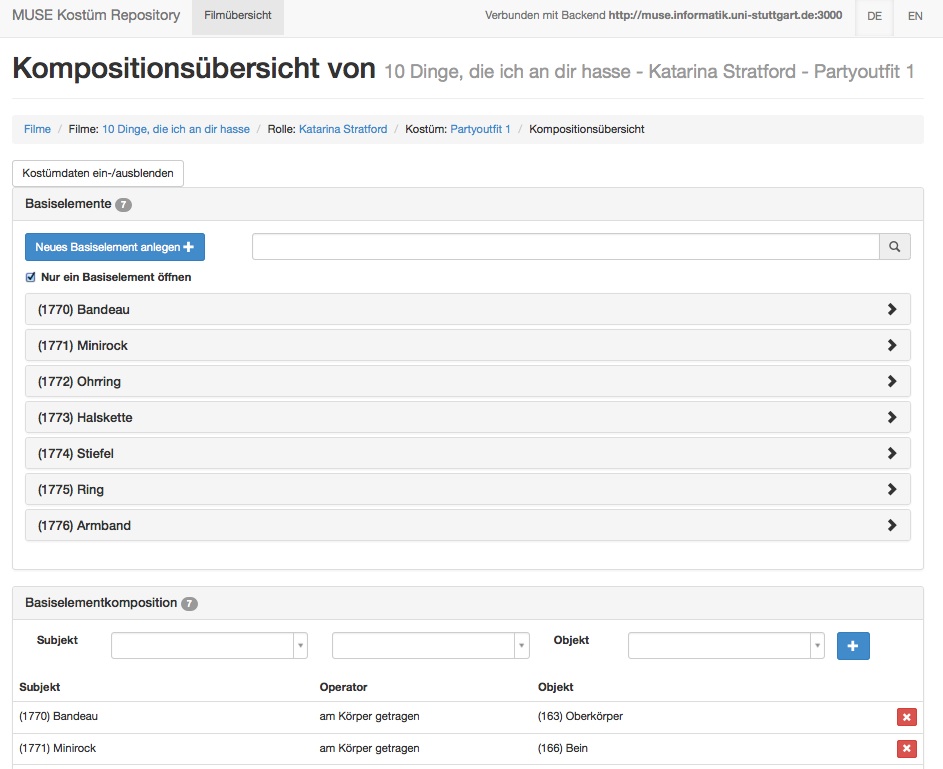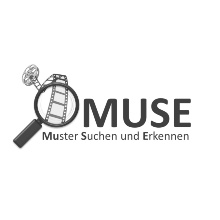The Project
MUSE is a clothes- and costume repository supporting to capture, store and analyze clothes and costumes. The concrete costumes occurring in films can be captured in their relevant details and analyzed to identify abstract costume patterns. Based on comprehensive taxonomies of costume relevant parameters MUSE enables advanced query- and analysis capabilities on concrete costumes. This supports the detection of costume patterns. Costume patterns are defined as an abstracted solution to determine an adequate textile expression of a film character.
Patterns and pattern languages are a concept that aims to capture and provide abstracted knowledge in a variety of domains. Originally developed in the architecture, the concept of pattern became popular in different fields of computer science. A pattern is a textual representation that follows a pre-defined format to document proven solutions of recurring problems.
As part of the Digital Humanities, MUSE adopts the concept of patterns to media science to reach a better understanding of vestimentary communication in films. For example, how can a costume communicate special character traits, the mood of a character or its transformation? How does it give information about the time and setting of the film? What "proven solutions" are used by costume designers to support an easy recognition of a cowboy or an outlaw? Answers to these and other questions will be approached by a pattern language for costumes.
To create such a pattern language for costumes the "concrete solutions" (i.e. concrete costumes occurring in films) need to be analyzed in detail in order to be able to identify the “abstract solution". Therefore MUSE supports a comprehensively capturing of costumes to enable advanced analysis of this costume data. To capture the costumes in a structured way, MUSE is based on extensive taxonomies. The taxonomies structure the costume relevant parameters as domain-specific knowledge that enable to capture every costume in detail: therefore the costume gets divided into base elements (like pants, shirt, shoes, etc.), their primitives (like pants consists of trousers, waistband, closure, etc.) and properties (color, material, design, function, condition, etc.) as well as operators (a shirt for example is "worn on” the body and has a relation to the pants called "worn above ").
The following screenshot depicts a list of the basic elements that compose a certain costume as well some of the relations between these basic elements (since MUSE is in German the content of the screenshot is German).

MUSE Screenshot
Publications
- Barzen, Johanna: Wenn Kostüme sprechen – Musterforschung in den Digital Humanities am Beispiel vestimentärer Kommunikation im Film, Universität zu Köln, 2018.
Book Chapters
- Barzen, Johanna; Falkenthal, Michael; Leymann, Frank: Wenn Kostüme sprechen könnten: MUSE - Ein musterbasierter Ansatz an die vestimentäre Kommunikation im Film. In: Bockwinkel, Peggy; Nickel, Beatrice; Viehhauser, Gabriel (Hrsg): Digital Humanities. Perspektiven der Praxis, Frank & Timme, 2018.
Journal Papers
- Barzen, Johanna; Leymann, Frank: Quantum humanities: a vision for quantum computing in digital humanities. In: SICS Software-Intensive Cyber-Physical Systems, Heidelberg: Springer Berlin Heidelberg, 2019.
- Barzen, Johanna; Breitenbücher, Uwe; Eusterbrock, Linus; Falkenthal, Michael; Hentschel, Frank; Leymann, Frank: The vision for MUSE4Music. Applying the MUSE method in musicology. In: Hermann Engesser (Hrsg): Computer Science - Research and Development, Vol. 22(74), Heidelberg: Springer, 2016.
- Falkenthal, Michael; Barzen, Johanna; Breitenbücher, Uwe; Brügmann, Sascha; Joos, Daniel; Leymann, Frank; Wurster, Michael: Pattern Research in the Digital Humanities: How Data Mining Techniques Support the Identification of Costume Patterns. In: Hermann Engesser (Hrsg): Computer Science - Research and Development, Vol. 22(74), Heidelberg: Springer, 2016.
- Falkenthal, Michael; Barzen, Johanna; Breitenbücher, Uwe; Fehling, Christoph; Leymann, Frank: Efficient Pattern Application: Validating the Concept of Solution Implementations in Different Domains. In: International Journal On Advances in Software Vol. 7 (3&4), Xpert Publishing Services, 2014.
- Schumm, David; Barzen, Johanna; Leymann, Frank; Wieland, Matthias; Ellrich, Lutz: Business Process Automation for Costume Management in Film Making: An Insight into Processes, Roles, and Document Structures. In: EMISA Forum. Vol. 32 (1), Gesellschaft für Informatik e.V. (GI), 2012.
Conference Paper
- Fehling, Christoph; Barzen, Johanna; Breitenbücher, Uwe; Leymann, Frank: A Process for Pattern Identification, Authoring, and Application. In: Proceedings of the 19th European Conference on Pattern Languages of Programs (EuroPLoP), 2015.
- Falkenthal, Michael; Barzen, Johanna; Breitenbücher, Uwe; Fehling, Christoph; Leymann, Frank: From Pattern Languages to Solution Implementations. In: Proceedings of the Sixth International Conferences on Pervasive Patterns and Applications (PATTERNS 2014).
- Schumm, David; Barzen, Johanna; Leymann, Frank; Ellrich, Lutz: A Pattern Language for Costumes in Films. In: Kohls, Christian (Hrsg); Fiesser, Andreas (Hrsg): Proceedings of the 17th European Conference on Pattern Languages of Programs (EuroPLoP 2012).
- Barzen, Johanna; Leymann, Frank; Schumm, David; Wieland, Matthias: Ein Ansatz zur Unterstützung des Kostümmanagements im Film auf Basis einer Mustersprache. In: Proceedings Modellierung 2012.
Workshop Papers
- Barzen, Johanna; Leymann, Frank: Quantum Humanities: A First Use Case for Quantum-ML in Media Science. In: ISAAI’19 Proceedings — Artificial Intelligence, Digitale Welt. Vol. 4(1), 2020, S. 102-103.
- Barzen, Johanna; Leymann, Frank: Patterns as Formulas: Patterns in the Digital Humanities. In: Proceedings of the Ninth International Conferences on Pervasive Patterns and Applications (PATTERNS), 2017.
- Fehling, Christoph; Barzen, Johanna; Falkenthal, Michael; Leymann, Frank: PatternPedia - Collaborative Pattern Identification and Authoring. In: Proceedings of Pursuit of Pattern Languages for Societal Change - Preparatory Workshop 2014.
- Barzen, Johanna; Leymann, Frank: Costume Languages As Pattern Languages. In: Proceedings of Pursuit of Pattern Languages for Societal Change - Preparatory Workshop 2014.
Demos
- Falkenthal, Michael; Barzen, Johanna; Dörner, Simon; Elkind, Vadym; Fauser, Jan; Leymann, Frank; Strehl, Tino: Datenanalyse in den Digital Humanities – Eine Annäherung an Kostümmuster mittels OLAP Cubes. In: Datenbanksysteme für Business, Technologie und Web (BTW), 16. Fachtagung des GI-Fachbereichs "Datenbanken und Informationssysteme" (DBIS), 02.-06.3.2015 in Hamburg, Germany, 2015.
Technical Reports
- Barzen, Johanna: Taxonomien kostümrelevanter Parameter: Annäherung an eine Ontologisierung der Domäne des Filmkostüms, Technical Report No. 2013/04.
Demos
- Falkenthal, Michael; Barzen, Johanna; Dörner, Simon; Elkind, Vadym; Fauser, Jan; Leymann, Frank; Strehl, Tino: Datenanalyse in den Digital Humanities – Eine Annäherung an Kostümmuster mittels OLAP Cubes. In: Datenbanksysteme für Business, Technologie und Web (BTW), 16. Fachtagung des GI-Fachbereichs "Datenbanken und Informationssysteme" (DBIS), 02.-06.3.2015 in Hamburg, Germany, 2015.
Poster
- Barzen, Johanna; Falkenthal, Michael; Hentschel, Frank; Leymann, Frank: Musterforschung in den Geisteswissenschaften: Werkzeugumgebung zur Musterextraktion aus Filmkostümen, At: DHd 2015.
- Barzen, Johanna; Leymann, Frank: Kostümsprache als Mustersprache: Vom analytischen Wert Formaler Sprachen und Muster in den Filmwissenschaften, At: DHd 2014.
- Barzen, Johanna: A Pattern Language for Costumes in Films, At: SummerSoc 2013 (Advanced School on Service Oriented Computing).
Contact

Johanna Barzen
Dr. phil.Lead of Research Area Quantum Computing & Digital Humanities


